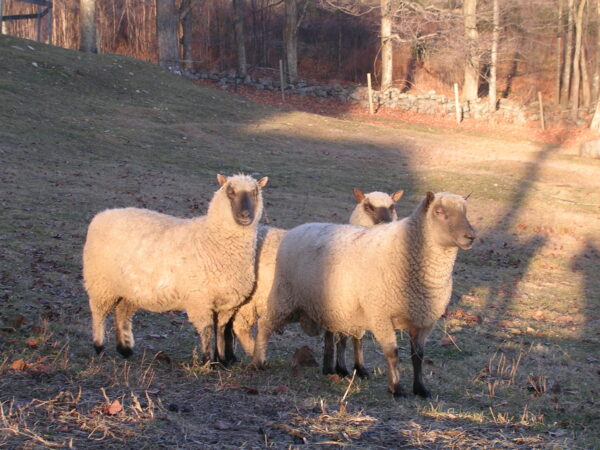
Breed Facts
Status:
Threatened
Use:
Meat, Wool, Milk
Adult Weight:
Rams: 175-200 lbs. Ewes: 130-160 lbs.
Temperament:
Docile, Alert, Active
Experience Level:
Novice – Intermediate
Notes:
Selected for production; polled; their breed association prohibits showing
CLUN FOREST SHEEP
The Clun Forest takes its name from the ancient market town of Clun in the southwest corner of Shropshire, England, near the border. Clun Forest isn’t a dense forest but rather an upland grazing area that is ideal for raising sheep. Some believe that the original Cluns were bred by the shepherds who lived there around a thousand years ago.
The breed has continued to be shaped by natural selection for over two centuries by shepherds in eastern Wales and southwestern Shropshire for hardiness, fertility, prolificacy, milking, and mothering ability, and longevity. In 1803, the Rev. Joseph Plymley mentions the breed in his writings for the Board of Agriculture, describing them as being polled and with white faces. It has been reported that by the mid-1830s, Cluns still appeared white-faced and polled, but their appearance began to change due to crosses with some local breeds, including Long Mynd, Hill Radnor, and Shropshire, resulting in darker head coloring. The Clun Forest Sheep Breeders Society was formed in Great Britain in 1925 “to secure the purity of lineage and fixity of type.” They combine the best of hill and lowland sheep breeds.
Two Clun Forest rams and thirty-nine ewes were imported to North America in 1970 by Tony Turner, and one additional ram was imported to Nova Scotia a short time later, and two additional importations were made from the late 1970s and mid-1980s. Due to import restrictions, semen from UK and Dutch rams was imported in the mid-200s.
The North American Clun Forest Association was established in 1974. The breed has proven adaptable and useful, and it is now distributed from Ontario to Hawaii. As part of its emphasis on production qualities, the breed association prohibits showing and will only register rams that are born as twins.
Clun forest ewes weigh 130-160 lbs. and rams 175-200 lbs. Clun Forest sheep are creamy white with dark brown faces and legs. They have forelocks of white wool, but little wool below the knees and hocks. They have small, upright ears that give them a very alert appearance, and their black hooves rarely need trimming.
Both rams and ewes are polled. Ewes are good mothers and usually produce twins. Rams tend to be “gentlemen” with their shepherds, but they are aggressive breeders.
The wool is medium, with a staple length of 6 to 10 cm and a fleece weight of 4 to 7 pounds. Fiber diameter ranges between 25 to 33 microns. The wool is dense, relatively free from kemp and black fibers, and uniform in quality, and is suitable for both beginning and expert fiber artisans. Clun Forest wool cannot be wet-felted.
The sheep are alert and active in disposition, but good-natured and easy to handle. They are worm resistant. This triple-purpose breed’s characteristics make it a natural choice for grass-based production, as they are easy keepers and excellent producers, and are a good choice for novice to intermediate farmers.
Did you know:
When farms and farmers face a crisis, rare livestock breeds are more likely to be lost. That’s why The Livestock Conservancy offers Emergency Microgrants year-round. As the economy tightens, off-farm jobs are lost, herds are downsized, veterinary emergencies happen, and calamities such as floods, fires, and tornadoes continue. Help us help them. Click here to support the Emergency Response Fund with your gift today.
You may be interested in…

Breed Facts
Status:
Threatened
Use:
Dual
Adult Weight:
150 -200 lbs
Temperament:
Docile
Experience Level:
Novice – Intermediate
Notes:
Selected for production
You may be interested in…




